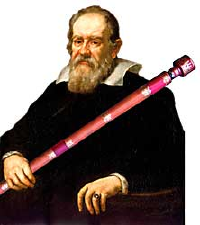 General Information
General Information
Author:
Lutz Pietschker
Version: 2010-12-31
Paper Modelling | Home Page | Links | What's New
 General Information
General Information
AstroMedia is a company that specialises in functional technical and scientific models made of cardboard, with a look that is often in the style of 19th century brass instruments. As you may expect from the company name, thematically their range of models is centred on, but not limited to, astronomy. All their models function like the real thing, which obviously limits the "pure cardboard experience"- you just can't make optical lenses from cardboard, for example. Many models come with pre-punched parts, so cutting is usually not necessary. This does not mean that they are easy to build, in particular if you expect them to function precisely and smoothly. Most of them are definitely not for beginners; on the other hand, as a beginner you can do worse than gain experience from building a relatively cheap orrery twice because your first attempt was not quite on the mark.
The models are usually in 1:1 scale; those I know are designed very well, making the best of the materials available and often using unexpected "household" materials (how about a telescope made from ordinary drainpipes? AstroMedia supplies high quality lenses and some appliances, your local building supply shop the tubes.)
(Click image to show it in large size in a new window.)
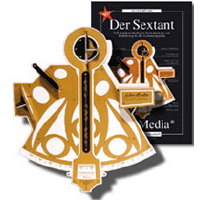
|
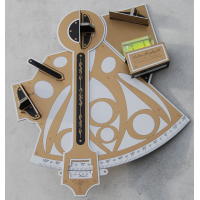
|
The
sextant
(Design: Klaus Hünig) is a replica of the nautical instrument that was invented in 1731 independently by John Hadley and Thomas Godfrey. It uses polished-steel mirrors and has a sunlight filter to make "shooting the sun" possible without risk. The arm ("alhidade") rotates around a joint and takes the "index mirror" with it.
A clip-on artificial horizon is available to enable working without a visible horizon. The right-hand side picture shows the model as I built it, with sun filter and artificial horizon attached. |
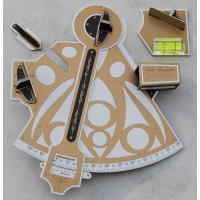
|
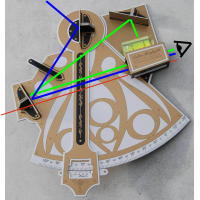
|
Same view, but with the sun filter (upper left) and artificial horizon (upper right) removed.
The right-hand side picture shows the way the light rays take: Blue is the way to the object, reflected by both mirrors, red is the direct view to the horizon or reference object. The green line indicates how the artificial horizon is reflected into the observation tubus. |
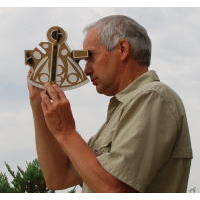
|
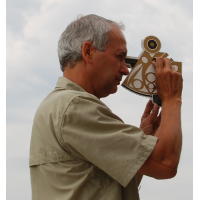
|
Using the sextant: Looking through the observation tube, the eye sees the reference (horizon) to the left of the fixed mirror, aligning it with a reference line drawn on the mirror ("real" sextants have optics in the observation tube for this purpose, here the tube is just that- a tube). I grip the sextant by the sturdy handle on the right side and move the alhidade (moveable arm) until the object is aligned with the horizon. |
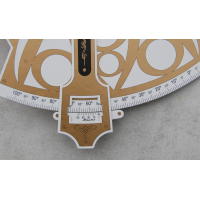
|
Now I can read the angle between object and horizon on the scale. The minute scale allows to read as exact as 5' (1/12 degree)- in theory only, for the instrument is not that exact. Still, it can serve as a training tool to learn how to use a sextant and to understand the way it works.
All in all a fine little model I would not have missed. |
|
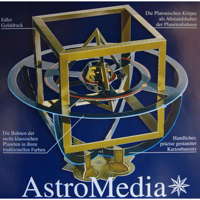
|
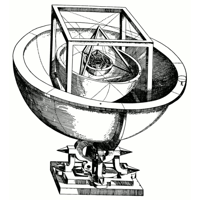
|
The "Mysterium Cosmographicum" (world mystery) was an attempt of Johann Kepler, astronomer and mystic, to explain the relative radii of our sun's planet's orbits, of which only six were known at the time. It was published as a book; Kepler himself never built a physical model, but some museums have done by now.
Astromedia has created a very nice model of this. I built it without changes and with no problems. All parts are pre-punched and fit very well. |
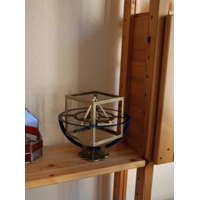
|
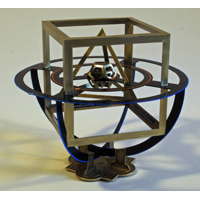
|
The idea of the world mystery is that the releations between the planet's orbit radii are the same as those of the inner and outer circles of the five
platonic polyhedra. From the outside to the sun, these are the cube (hexahedron, outer circle=Saturn), the tetrahedron (outer circle=Jupiter), the dodecahedron(outer circle=Mars), the icosahedron (outer circle=Earth) and the octahedron(outer circle=Venus, inner circle=Mercury). Unfortunately, though this was aesthetically satisfying, it was scientific rubbish.
The completed model has a size of about 20x20x18 cm. |
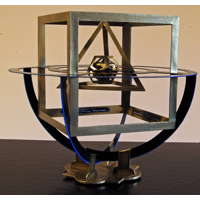
|
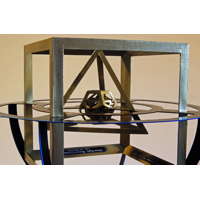
|
Two views from near the orbit plane. The blue outer rim of the model represents Jupiter's orbit.
Though the relative positions of the tetrahedron and the cube do not look quite right, they are. You can check by looking along the faces of the polyhedra, and indeed they match perfectly. |
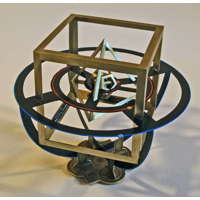
|
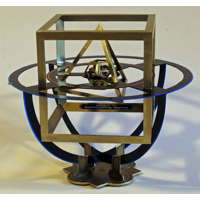
|
Two more views of the model. I enamelled all "golden" parts except the foot with acrylic gold colour because I thought it would look better than the original gold print and also because I found no gold enamel to paint the edges taht would match the printed colour exactly; so I had to make the face colour fit the edges. |
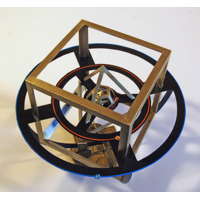
|
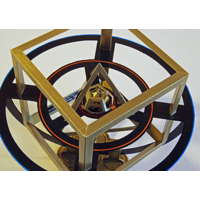
|
As you can see, the inner models are pretty small, the inner orbits (Venus and, even more so, Mercury) are hardly visible. |
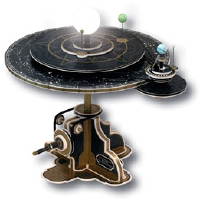
|
Copernicus' orrery is a functioning model of the relative movements of the inner planets and Earth's moon. All orbit sizes and relative orbit times are correct, and Earth's axis remains in the same position towards the sun, explaining seasons.
Not built yet, awaiting its chance. |
As the author of this page I take no expressed or implied responsibility for the content of external links; opinions expressed on such pages are not necessarily mine. The web space provider is not responsible for the contents of this page or any linked pages.
Written and published by Lutz Pietschker. Please send comments about technical problems to the
site master.
-Made with a Mac!-
, last change 2011-03-12